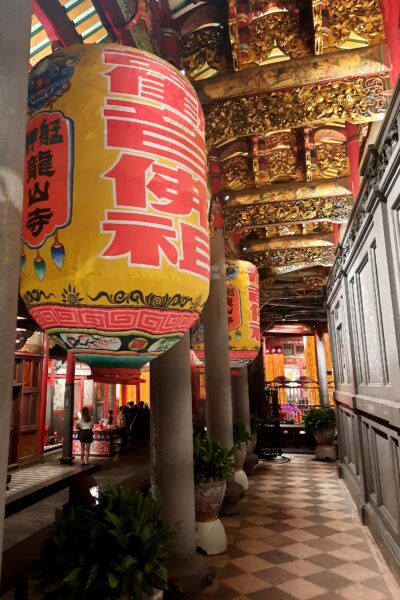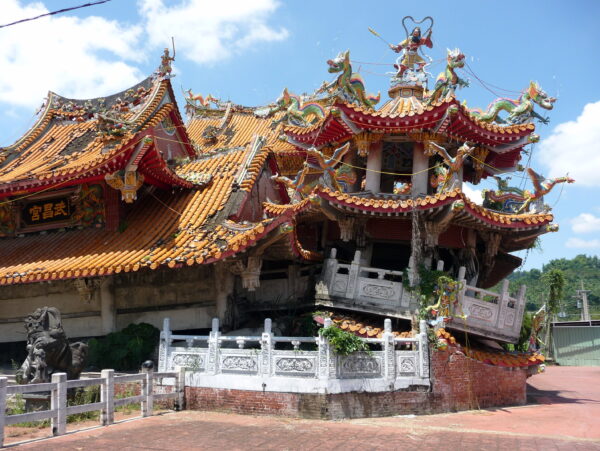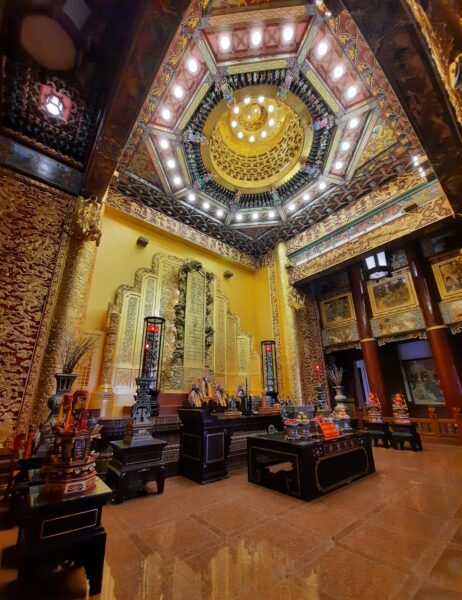More than 15,000 registered places of worship serve Taiwan’s 23.9 million people. The vast majority, over 12,200, are dedicated to mainstream beliefs, which in Taiwan means a blend of Buddhism, Taoism, and popular faith. Throughout the country there are also around 2,800 Christian churches and at least 10 mosques.
Some of these buildings are new and blandly functional. But many others are striking pieces of architecture filled with stunning icons and dazzling religious art; it’s no wonder they feature in almost all of the Taiwan guided tours that we organise for our clients. Choosing the six finest temples is no easy task — but to inform and entertain our readers, and help those planning to embark on a private tour of Taiwan, here we present half a dozen religious sites that are open to the public and guaranteed to make a lasting impression.

Lanterns inside Longshan Temple
Piety in Old Taipei: Longshan Temple
It’s hard to say if the 285-year-old Mengjia Longshan Temple (not to be confused with an identically named and equally worthwhile shrine in Lukang) is a finer place of worship than the slightly newer Dalongdong Baoan Temple. But if seeing religion in action is your goal and you’re pressed for time, we’d say come here first.
The daughter shrine of Longshan Temple in Jinjiang County, Fujian — the region in China from which many of Wanhua’s 18th-century settlers hailed — this landmark is located on the Buddhist side of Taiwan’s religious spectrum. Guanyin is the centre of attention; she’s kept company by Guan Gong (on the left at the back and easy to locate thanks to his red face) and Mazu (the main deity in the rear chamber) among others. The Mazu effigy has been here since 1793, when she was donated by a guild of merchants whose members often made the perilous voyage between Taiwan and the coast of China.
In the evening, when this temple has an especially sublime atmosphere, you’ll likely see a line of lonely hearts near Guan Gong, waiting to offer a prayer to the Old Man Under the Moon. If you take a close look at the altar dedicated to this Cupid-like god, you’ll see a bowl of short red threads. After praying, each visitor takes one of these threads, which symbolise the ancient belief that every human is tied to and destined to find his or her life partner. The dozens of photos of smiling couples represent success stories; many of those who later find love, and attribute their happiness to the Old Man’s intervention, return to communicate their gratitude and leave a testimony to his powers.
Longshan Temple isn’t the only sight to see in Wanhua. Far from it: Nearby Xiyuan Road has more than a dozen shops which specialise in Buddhist icons and religious necessities. Herb Alley is lined with businesses that deal in medicinal and culinary herbs, while the renovated street known as Bopiliao has a number of 19th- and early 20th-century buildings that deserve exploration. All of these sights are close to Longshan Temple Station on the metro’s Blue Line.
Hsinchu Du Cheng Huang Temple: A Shrine to Officialdom
Because Hsinchu is so closely identified with Taiwan’s world-famous tech sector, few international travellers realise it has a long history and several intriguing attractions. Among these is Du Cheng Huang Temple, an always-bustling holy place.
Like other city-god and town-god shrines around Taiwan, this temple venerates Cheng Huang Ye, ‘lord of the city walls and moat’, a deity believed to protect both the physical city and its inhabitants. Founded in 1748, the resident god was in 1889 declared to be the divine equivalent of a prefectural governor. This promotion was ratified by the emperor in faraway Beijing — this being six years before Taiwan became a colony of Japan — and gave him a status higher than that of any other city god. Within the temple, Cheng Huang Ye is accompanied by effigies of his wife and his two sons. A huge iron abacus reminds people that the heavens tally their sins and their good deeds and that eventually they’ll be called to account.
Hsinchu Du Cheng Huang Temple is also a foodie magnet. At least three dozen vendors and eateries do business in the warrenous alleyways that surround it. Several of them specialise in two dishes which every Taiwanese associates with Hsinchu: pork meatballs in clear yet flavourful soup and rice vermicelli served with bean sprouts and small strips of pork. It’s a great place to get an inexpensive lunch while soaking up local colour.
Wuchang Temple: Where Disaster Struck

The ruins of Wuchang Temple
Dedicated to the Lord of the North Pole — the most senior deity in control of natural phenomena — the current edition of Wuchang Temple was inaugurated in 2013 as a replacement for an earthquake-shattered building. The ruins of the latter stand on the same plot, a monument of sorts to the powerful tremor that caused death and destruction throughout central Taiwan on September 21, 1999. The disaster is known as the Jiji Earthquake because the epicentre was right here in Nantou County’s Jiji Township, a 40-minute drive west of Sun Moon Lake.
The new Wuchang Temple, which houses effigies and other items salvaged from the quake-smashed building, isn’t nearly as fascinating as the wreck it replaced. The collapsed ground floor and the listing drum tower are quite a sight. The three Taoist immortals (representing blessings, wealth and longevity) who once stood on the roof’s ridge now lie face down on the tiles.
Long before the 1999 calamity, Jiji was popular with tourists. This little town is served by a scenic branch railway and often visited by roadtrippers driving southward to Alishan on Highway 21, just one of Taiwan’s many scenic mountain routes.
Blood and Ritual in the South: Nankunshen Temple
Around 45 minutes by car from the splendid cluster of ancient shrines and other relics in central Tainan, Nankunshen Temple traces its origins to the arrival of an unmanned boat on the coast here sometime in the first half of the 17th century. The vessel carried five effigies of gods which local fishermen immediately brought ashore and placed in a temporary shrine. Convinced of the idols’ efficacy — how could an unguided boat make it across treacherous waters were it not for divine protection? — they began to worship them. The results, it’s said, were obvious. The fishermen caught more fish than ever and smudges of incense from the shrine helped the sick regain their health.

Nankunshen Temple’s Lingxiaobao Hall
Since then, the temple has grown ever bigger, grander, and more popular. Sundays are exceptionally lively and visitors are likely to see noisy processions which feature tang-ki, men possessed by gods. To demonstrate how their supernatural patrons protect them from injury, they cut themselves on the face, chest and back with swords, small axes, and other sharp instruments. Some pierce their cheeks with long needles. Others speak in tongues. No one hopes to become a tang-ki and it’s said that refusing to serve if chosen by a deity will bring about great misfortune until the anointed person accepts his role. (Very few tang-ki are female.)
The temple also contains a great deal of engrossing art. Lingxiaobao Hall is a recent addition to the complex and, rather than feature images of Chinese myths and legends like the majority of temples, it’s decorated with paintings of Taiwanese scenery, culture, cultural figures, and sporting heroes.
Where an Era Ended: The Five Concubines Temple in Tainan
This is a choice that’ll likely surprise Taiwan temple aficionados. The Five Concubines Temple was founded as a memorial of sorts to a quintet of ladies who decided that, rather than flee, they’d accompany their master to the next world. The five were concubines of Prince Ningjing, the nominal leader of the Ming pretender state that had established itself in Tainan after giving the Dutch the boot.
Set in a peaceful park full of gnarled trees, this smallish place of worship is a dignified reminder of events long ago. Instead of the usual sternly male door gods, the entrance bears body-length portraits of two of the concubines. And beside the grave where the ladies are said to have been buried there’s a tiny shrine dedicated to a pair of faithful eunuchs who also killed themselves rather than submit to a new regime.
The Sea Goddess in Magong: Tianhou Temple
Appropriately, the most famous place of worship in the Penghu archipelago is devoted to Mazu, the goddess of the sea. While it isn’t as large as some of the other edifices on this list, Tianhou Temple in the heart of Magong City has been around for over 460 years and radiates charm. Visitors will find themselves especially beguiled by the finely carved wooden windows. The principal Mazu effigy is unusually large and old. Carved from a single piece of solid wood weighing about 150 kg, it’s said to be at least 700 years old.
History buffs will see something of interest at the back of the temple on the right — a tall stele (a narrow stone pillar used to make announcements) that dates from 1604. The incised script on it is almost impossible to make out but the meaning is straightforward: A demand by a Ming dynasty general that the Dutch East India Company flotilla then anchored nearby leave the islands. That expedition was part of the company’s efforts to establish an outpost that could develop trade with China. Those attempts eventually resulted in the Dutch base at what’s now Tainan in Taiwan.
Plan Your Taiwan Trip Now
Life of Taiwan are experts at curating small-group and family tours of Taiwan which offer not just great cultural and culinary experiences but also luxury at every stage. As of mid-June 2024, of 98 Tripadvisor reviews, 92 gave us the highest five-star rating. Contact us today to begin planning the trip of a lifetime!
